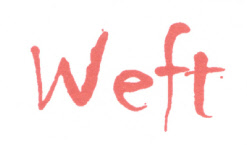
Indus Valley Quilts
Our quilts have been primarily collected in Sindh Province, Pakistan. Quilts are an old tradition in the area of the valley of the Indus River, extending from Sindh into Punjab, Rajasthan and Gujarat. The border between India and Pakistan has divided what was once a more coherent cultural area.
The cultural significance of the quilts is difficult to comprehend. They are mentioned in old Urdu and Sufi poetry. They are mostly made as dowry or trousseau items, but they are also donated to the holy men of the area, both Hindu and Sufi. They are associated with snake charmers. Snake charmers are not entertainers, they perform a religious function in the area, that crosses over both the Hindu and Muslim religions.
Functionally, the quilts are used as bed covers, sunshades, wedding decorations, furniture covers, and as a wrap in cold weather.
We roughly divide the quilts into several categories. These categories do not relate to their cultural or geographic origin, but to their design and structure.
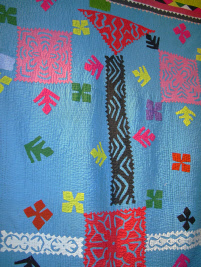
Rilli or ralli is the term used to describe the complex applique or geometric quilts. These are the most well known of the quilts. The geometric design quilts are often not unlike European or American quilts. Some of the applique quilts draw comparison with Henri Mattisse’s paper cutouts, and it is known that he had one in his collection of textiles, and that the quilts were exhibited internationally in the 1950s.
Rilli applique quilt
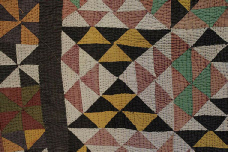 Rilli geometric quilt
Rilli geometric quilt
The more usual quilt is made from scraps of cloth sewn together by hand then quilted.
Usually there is an internal layer of cloth that is made of very old scraps. The
front of the cloth is often floral, the reverse usually plain.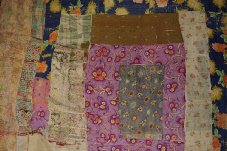 The cloth will often
be remnants from mills or clothing factories that are sold cheaply. Remnants from
countries including China, Japan and Thailand can be seen in the markets. A misprint
of a design made in China for the African market might appear in a quilt in Sindh.
Quilting can often be very fine, and usually a pattern is made by using varying colour
threads.
The cloth will often
be remnants from mills or clothing factories that are sold cheaply. Remnants from
countries including China, Japan and Thailand can be seen in the markets. A misprint
of a design made in China for the African market might appear in a quilt in Sindh.
Quilting can often be very fine, and usually a pattern is made by using varying colour
threads.
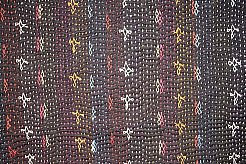
Saami quilts are associated with people who collect snakes for snake charmers. They are usually very finely quilted on a dark cloth, black or dark blue, but sometimes brown. They frequently have added embroidery to supplement the quilting.
Cotton cloth has been an export of the Indus Valley since antiquity. Due to the harsh climate, not many early cotton fabrics are found in the area itself, although Indus Valley cotton has been found in late Egyptian tombs and as lining for old Japanese kiminos. Most of the quilts we find are from the 1950s, 60s and 70s. Modern synthetic cloths such as rayon last longer and keep their colour longer.
Ref:World Textiles. John Gillow and Brian Sentance. Thames & Hudson/Bullfinch. 1999
Threadlines Pakistan. Feliccia Yacopino. Govt of Pakistan. 1977
Colours of the Indus. Nasreen Askari and Rosemary Crill.Holberton/V&A Museum. 1997